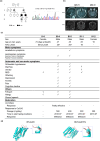Genetic profiles of multiple system atrophy revealed by exome sequencing, long-read sequencing and spinocerebellar ataxia repeat expansion analysis
- PMID: 39152783
- PMCID: PMC11555020
- DOI: 10.1111/ene.16441
Genetic profiles of multiple system atrophy revealed by exome sequencing, long-read sequencing and spinocerebellar ataxia repeat expansion analysis
Abstract
Background and purpose: Multiple system atrophy (MSA) is a progressive, adult-onset neurodegenerative disorder clinically characterized by combinations of autonomic failure, parkinsonism, cerebellar ataxia and pyramidal signs. Although a few genetic factors have been reported to contribute to the disease, its mutational profiles have not been systemically studied.
Methods: To address the genetic profiles of clinically diagnosed MSA patients, exome sequencing and triplet repeat detection was conducted in 205 MSA patients, including one familial case. The pathogenicity of variants was determined according to the American College of Medical Genetics and Genomics and the Association for Molecular Pathology guidelines.
Results: In the familial patient, a novel heterozygous COQ2 pathogenic variant (p.Ala351Thr) was identified in the MSA pedigree. In the sporadic patients, 29 pathogenic variants were revealed in 21 genes, and the PARK7 p.Ala104Thr variant was significantly associated with MSA (p = 0.0018). Moreover, burden tests demonstrated that the pathogenic variants were enriched in cerebellar ataxia-related genes in patients. Furthermore, repeat expansion analyses revealed that two patients carried the pathogenic CAG repeat expansion in the CACNA1A gene (SCA6), one patient carried the (ACAGG)exp/(ACAGG)exp expansion in RFC1 and one carried the GAA-pure expansion in FGF14 gene.
Conclusion: In conclusion, a novel COQ2 pathogenic variant was identified in a familial MSA patient, and repeat expansions in CACNA1A, RFC1 and FGF14 gene were detected in four sporadic patients. Moreover, a PARK7 variant and the burden of pathogenic variants in cerebellar ataxia-related genes were associated with MSA.
Keywords: COQ2; PARK7; RFC1 and FGF14 repeats; multiple system atrophy; spinocerebellar ataxia repeat 6.
© 2024 The Author(s). European Journal of Neurology published by John Wiley & Sons Ltd on behalf of European Academy of Neurology.
Conflict of interest statement
The authors declare no actual or potential conflicts of interest in this paper.
Figures


Similar articles
-
Molecular genetics of hereditary spinocerebellar ataxia: mutation analysis of spinocerebellar ataxia genes and CAG/CTG repeat expansion detection in 225 Italian families.Arch Neurol. 2004 May;61(5):727-33. doi: 10.1001/archneur.61.5.727. Arch Neurol. 2004. PMID: 15148151
-
Frequency of FGF14 intronic GAA repeat expansion in patients with multiple system atrophy and undiagnosed ataxia in the Japanese population.Eur J Hum Genet. 2025 Mar;33(3):325-333. doi: 10.1038/s41431-024-01743-3. Epub 2024 Nov 27. Eur J Hum Genet. 2025. PMID: 39604554 Free PMC article.
-
The genetic landscape of sporadic adult-onset degenerative ataxia: a multi-modal genetic study of 377 consecutive patients from the longitudinal multi-centre SPORTAX cohort.EBioMedicine. 2025 May;115:105715. doi: 10.1016/j.ebiom.2025.105715. Epub 2025 Apr 23. EBioMedicine. 2025. PMID: 40273470 Free PMC article.
-
Recent Advances in the Genetics of Ataxias: An Update on Novel Autosomal Dominant Repeat Expansions.Curr Neurol Neurosci Rep. 2025 Jan 16;25(1):16. doi: 10.1007/s11910-024-01400-8. Curr Neurol Neurosci Rep. 2025. PMID: 39820740 Review.
-
Spinocerebellar ataxia type 6 and episodic ataxia type 2: differences and similarities between two allelic disorders.Cytogenet Genome Res. 2003;100(1-4):147-53. doi: 10.1159/000072849. Cytogenet Genome Res. 2003. PMID: 14526175 Review.
References
-
- Ahmed Z, Asi YT, Sailer A, et al. The neuropathology, pathophysiology and genetics of multiple system atrophy. Neuropathol Appl Neurobiol. 2012;38:4‐24. - PubMed
-
- Trojanowski JQ, Revesz T, Neuropathology Working Group on MSA . Proposed neuropathological criteria for the post mortem diagnosis of multiple system atrophy. Neuropathol Appl Neurobiol. 2007;33:615‐620. - PubMed
-
- Fanciulli A, Wenning GK. Multiple‐system atrophy. N Engl J Med. 2015;372:249‐263. - PubMed
MeSH terms
Substances
Grants and funding
- 2022YFC2009600/National Key Research and Development Program of China
- 2022YFC2009601/National Key Research and Development Program of China
- 31730108/National Natural Science Foundation of China
- 31921002/National Natural Science Foundation of China
- 32061143026/National Natural Science Foundation of China
LinkOut - more resources
Full Text Sources
Miscellaneous

